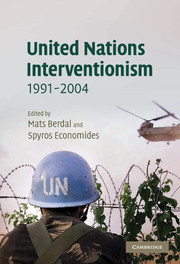2 - Cambodia
Published online by Cambridge University Press: 22 September 2009
Summary
The United Nations (UN) operation in Cambodia from 1992 to 1993 was, at the time, the most ambitious and expensive undertaking in the peacekeeping experience of the organisation. At a cost of around US $1.7 billion, 22,000 military and civilian personnel were deployed to implement the Comprehensive Political Settlement of the Cambodia Conflict, the Paris Agreement, which had been concluded at an international conference in Paris on 23 October 1991. That settlement made provision for a UN Transitional Authority in Cambodia (UNTAC) charged with holding the ring politically, so that elections under its aegis could determine the future governance of a country long afflicted by violent upheaval and human suffering.
UNTAC was provided with exceptional resources but its mandate was restricted to peacekeeping. Peace enforcement, which had been demonstrated early in 1991 in Operation Desert Storm, was not part of UNTAC's remit, which was confined, in essence, to a quasi-administrative role. The critical problem confronted by UNTAC virtually from the outset of its deployment was how to discharge its responsibility for filling a political vacuum in the face of obstructive violence by contending Cambodian parties.
The notorious Khmer Rouge refused totally to cooperate in implementing the Paris Agreement, which it had signed, while the incumbent administration in Phnom Penh used violence to force the outcome of the elections. In the event, UNTAC took a calculated risk in embarking on elections, which were conducted without serious disruption.
- Type
- Chapter
- Information
- United Nations Interventionism, 1991–2004 , pp. 32 - 64Publisher: Cambridge University PressPrint publication year: 2007
- 1
- Cited by

